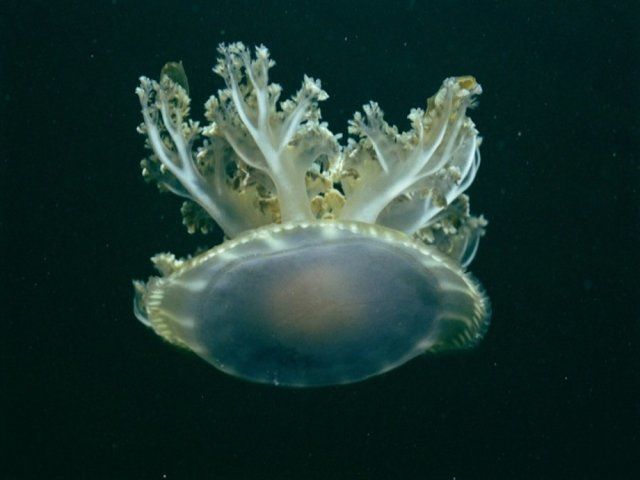(单词翻译:单击)
听力文本
This is Scientific American — 60-Second Science. I'm Annie Sneed.
Humans are hardly alone in their need for sleep—as any cat owner knows. But what about other, very different animals?
"In thinking about this...we wanted to use an evolutionary argument to figure out what is the simplest animal to sleep." Ravi Nath, a graduate student of biology and bioengineering at Caltech.
"We decided to approach it from a conservation point of view, how conserved the sleep state is. And looked back into the animal tree and specifically looked at jellyfish." Claire Bedbrook, also a biology and bioengineering graduate student at Caltech.
Jellyfish have no central nervous system. "They do have neurons—their nervous system is a sort of loose set of neurons that control the animal's behavior. There's no control center."
Nath, Bedbrook and the rest of their team worked with a species known as the upside-down jellyfish. "Unlike jellyfish that we're probably most used to seeing in the wild, these jellyfish actually rest their bell on the seafloor, or in our case the tank bottom, and they pulse in place." These habits made this jellyfish easy to observe.

The researchers recorded the animals' behavior during the day and at night, to see if these jellyfish met the scientific criteria for sleep. "Those three behavioral criteria are, first, that the animal goes through a period of quiescence where they are less active. The second is that during this quiescent state, the animals are not as responsive to environmental stimulus. And the third is that this quiescent state is actually necessary for the animal's well-being and survival."
The observations revealed that these jellyfish do in fact sleep. That's a big deal because for scientists "there was this assumption in the community that you needed to have a certain level of complexity"—namely a central nervous system—"to actually sleep. And I think this study really challenges that assumption." The finding is in the journal Current Biology.
So what does this study tell us about why animals sleep, and how sleep evolved? Bedbrook says that although more work needs to be done, they have some ideas. "One hypothesis that we really like is that any animal that has neurons will have a sleep state, and that sleep might be an intrinsic property of neurons." Nath agrees. "So neurons have a huge metabolic cost, and so maybe this period of sleep is a period of consolidated energy conservation that has evolved with neurons essentially."
So nerves might be keeping you up at night—but having nerves is what's probably putting you to sleep.
Thanks for listening for Scientific American — 60-Second Science. I'm Annie Sneed.
参考译文
这里是科学美国人——60秒科学。我是安妮·斯尼德。
人类并不是唯一需要睡眠的生物,养猫的人都知道这一点。但是其他非常特别的动物需要睡觉吗?
“想到这个问题时,我们想利用进化论论据来找出需要睡眠的最低等动物。”加州理工学院生物及生物工程专业的研究生拉维·纳斯说到。
“我们决定从保护的角度进行研究,比如如何保护睡眠状态。我们回顾了动物树的成型,并着重关注水母。”克莱尔·贝德布鲁克也是加州理工学院生物和生物工程专业的研究生。
水母没有中央神经系统。“水母有神经元,它们的神经系统是一套松散的神经元,控制着水母的行为。但是没有控制中心。”
纳斯、贝德布鲁克和团队其他成员研究了一种名为“仙女水母”的物种。“与我们在野外常见的水母不同,仙女水母会将伞状体放在海底,在我们的实验中它们是放在水箱底部,然后它们会开始跳动。”这些习性让仙女水母易于观察周围的情况。
研究人员记录了仙女水母白天和夜晚的行为,以观察它们是否符合睡眠的科学标准。“睡眠有三种行为标准,第一,动物会经历活动力较低的静止期。第二,在静止状态下,动物对环境刺激的反应灵敏度减弱。第三,这种静止期对动物的健康和生存来说是必不可少的。”
观察结果显示,仙女水母的确会睡觉。这一结果对科学家来说意义重大,因为“科学界有种假设,需要达到一定程度的复杂性”——即要有中枢神经系统——“才会产生睡眠。我认为这一研究挑战了这种假设。”这项研究结果发表在《当代生物学》期刊上。
就动物为什么睡觉以及它们睡眠的进化方式,这项研究是怎么说的?贝德布鲁克表示,虽然需要进行深入研究,不过他们已经有了一些想法。“我们比较喜欢的一种假说是,任何拥有神经元的动物都会有睡眠状态,睡眠可能是神经元的本质属性。”纳斯赞同这种假设。“神经元的代谢值非常高,从本质上说,也许这种睡眠期是随神经元进化出的综合节约能量期。”
因此,神经紧张可能会令你晚上无法入睡,但是拥有神经系统可能会让你安然入睡。
谢谢大家收听科学美国人——60秒科学。我是安妮·斯尼德。
译文为可可英语翻译,未经授权请勿转载!
重点讲解
重点讲解:
1. be known as 称为;叫做;
例句:The Qinghai-Xizang Plateau has long been known as the roof of the world.
青藏高原素有世界屋脊之称。
2. be used to doing sth. 习惯于;
例句:She wasn't as proud and quick-tempered as her mother, but she was used to getting what she wanted.
她不像她母亲那样孤傲和脾气暴躁,但也是习惯了要什么有什么。
3. at night 在晚间;在夜里;
例句:Fireflies give off flashes of light when they fly at night.
萤火虫夜间飞行时发出闪光。
4. go through 经历,经受;
例句:I believe that all that you go through here must have some value, therefore there must be some reason.
我相信的是我们现在经历的一切一定有价值,因此必有某些道理,也必然预示着有些事情“将要发生”。


